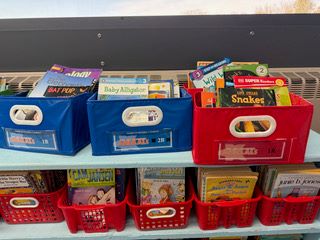Learning Together At Botelle
Multi-age Classrooms Spans All Grades
By Avice Meehan

Students are free to choose from among books that match their reading levels.
Picture this: First and second graders clustered in groups of three, working on identifying words to include in a glossary for reports about endangered animals. Their research topics range from bats to elephants, with a few amphibians thrown in for good measure.
Primary school teacher Debra Tallon, a veteran educator at Botelle Elementary School, moves among the students to answer questions, solve problems and offer encouragement. Words like scientist, poison and habitat can be heard above the quiet hum. So can words like bat and leopard.
It would be tough to distinguish the six second graders from the 10 first graders. Look more carefully, however, and it becomes apparent that children are working with books and resources that are keyed to their reading level and that some are receiving one-on-one reading help from a paraprofessional or specialized teacher. Their final reports, part of a non-fiction unit, will be evaluated according to different standards—the second graders, for example, are expected to include a topic sentence.
“When you teach in a multi-age classroom, you have to be aware of the standards for each grade,” Tallon explained, noting she may work with younger students in small groups to help them decode words while pushing more advanced students to read for deeper comprehension.
The program at Botelle was rolled out slowly over a period of years—with delays caused by Covid—and was not fully implemented for upper primary students (Grades 5 and 6) until the 2023-24 school year. The only exception is math, which is taught in grade level groupings.
Botelle’s multi-age model has recently come under criticism from some in Norfolk, including a few parents and several elected officials. They have compared Botelle unfavorably to the Colebrook Consolidated School, which uses a single-grade teaching model and posts higher scores on state tests.
Principal Lauren Valentino said she believes parents have a positive view of the multi-age model, while acknowledging that it requires staff and faculty who thrive in a collaborative environment. Botelle has had a consistent teaching and support staff for the past two years and has been named a school of distinction by the state for student growth.
“Every year when we introduce the program to new parents, the common denominator is ‘that makes sense.’ They are thrilled, for the most part, to have the same teacher for two years,” said Valentino. “Elementary school is the only time we put [children] into age boxes. When you think about it in a real-life scenario, it is surprising how many environments are multi-age.”
Tallon was one of two teachers who helped introduce the multi-age teaching model at Botelle in the fall of 2017 with a combined kindergarten and first grade classroom. At the time, even fans of the approach—including current Board of Education Chair Virginia Coleman-Prisco—were skeptical when it was rolled out. Now, with a child in the combined fifth and sixth grades, Coleman-Prisco is fully on board.
“Teachers need to know what to do, and parents need to understand the pluses and minuses,” she said. “There’s an assumption that children are being taught at a lower level. Instead, we are aiming for the top for everyone.”
Schools across Connecticut make use of combined classes, particularly when faced with lower enrollments. It has been a fact of life at the Lee H. Kellogg School in Falls Village for decades, although Kellogg uses a slightly different approach and enrolls students through grade 8.
“I was really excited about coming to Kellogg. It made sense to me,” said Stacey Calo, who became principal there in 2021, with a background as an instructional coach. “You just have to be flexible and make it work. Imagine if you didn’t do multi-level?”
From Calo’s perspective, it would come with a social, intellectual and financial cost: students would be isolated in small groups, they would have fewer role models, and the town would have to hire additional teachers. Kellogg enrolls students in kindergarten through eighth grade and has made multiple adjustments over the years as enrollments have fluctuated. Kindergarten is now a separate class but first and second grade are taught in a combined class. As is the case at Botelle, students separate for math instruction.
